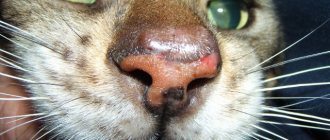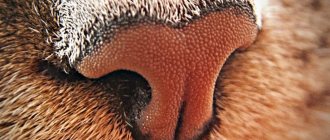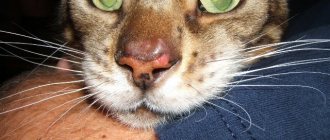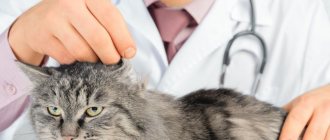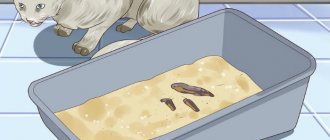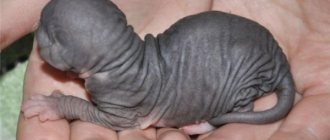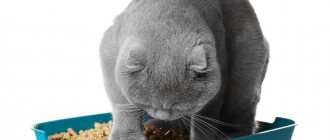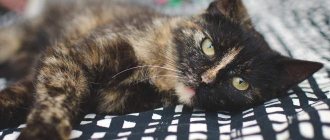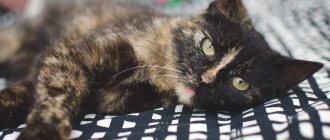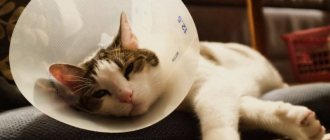It is believed that a healthy cat's nose should normally be wet and cold. However, there are situations when there are no health problems, but the nose is dry. The owner should know in which cases there is no need to worry, and what symptoms are alarming. If there is cause for alarm, the owner needs to show the pet to a veterinarian, who will diagnose and prescribe treatment.
According to veterinarians, if a cat has a pale nose for a long time, this may indicate anemia or dehydration.
Symptoms and infection
If the owner notices that the furry pet is sneezing, his nose is running, his eyes are watering, and he refuses his usual food - this is a reason to think.
Perhaps the cat fell ill with a very common disease - rhinotracheitis. Feline rhinotracheitis is a disease caused by the herpes virus FHV-1. With improper care, the disease quickly progresses into the acute phase and is dangerous due to side effects. Another name for this disease is feline herpes virus. The incubation period of the virus lasts up to 10 days.
In a sick animal, the eyes and respiratory organs are primarily affected. Cats of all ages and breeds are susceptible to this infection. However, kittens and older individuals are more at risk than others. The reason is a decrease or insufficient development of immunity.
The first signs of rhinotracheitis
The feline herpes virus most often manifests itself in the autumn-spring period. This disease is difficult to recognize immediately and is easily confused with a common cold. The owner needs to take a close look at the pet.
The following signs will help identify rhinotracheitis in a cat:
- Frequent and sudden sneezing;
- High temperature, over 39 degrees;
- Inflammation of the mouth and eyes;
- Refusal to eat and decreased activity;
- Difficulty swallowing, drowsiness and lethargy;
- Lymph nodes are enlarged;
- Mucous and purulent discharge from the nose, eyes, urethra.
In small kittens, the virus is very painful. Their immune system is still very weakened and all obvious symptoms are especially noticeable. For a thorough examination, you must take your pet to a veterinarian. The specialist will examine the cat’s eyes, nose and skin, and listen to the lungs. Carefully study the medical history.
To accurately assess the disease you need to take:
- swab and scrapings from the cat’s mouth;
- clinical blood test to determine the level of leukocytes;
- or PCR - a study that will more accurately determine the presence of the virus.
Why does a cat's nose turn red?
If a cat has a dry, hot and red nose, eats poorly, is not active, spends a lot of time lying down, does not approach people and hides from them, then it is likely that she is sick. The cause of a red nose in a kitten and an adult cat can be :
- infectious rhinitis that developed as a result of rhinotracheitis, calcivirosis and other respiratory diseases;
- sinusitis;
- mechanical, thermal and chemical irritants (dust, hot steam, harmful gases);
- allergic reaction to plant pollen, strong-smelling substances, etc.;
- autoinfections with the nose’s own microflora with decreased immunity;
- injuries and bruises of the nose.
© shutterstock
The reason that a cat's nose has become red can also be benign and malignant tumors in the sinuses and nasal passages, as well as foreign bodies in them.
The causative agent of rhinotracheitis
The danger is that the cat can get sick even while at home. For example, the owner brought the infection from the street on the soles of his shoes or stroked someone else's infected cat while visiting. Also, a pet can catch the virus while walking or at an exhibition. After all, the disease is transmitted by airborne droplets.
The main causes of pet infection:
- communication with a carrier of the virus;
- Sharing toys, tray or utensils with an infected animal by a healthy cat.
Danger of the virus to people
Most experts say that a sick animal does not pose a danger to humans. People also get herpes, but of a completely different type. Rhinotracheitis is a seasonal disease in cats. A person also tends to get sick in the fall or spring.
So, if the owners and the cat caught a cold at the same time, it’s most likely just a coincidence. However, while there is a sick pet in the house, it is recommended to refrain from guests. These measures will help prevent the dangerous virus from being carried to another place and infecting other animals.
General principles for troubleshooting
- Rinse the nose with hypertonic saline solutions at room temperature;
- Use of vasoconstrictor drops;
- Avoiding hypothermia and drafts;
- Normalization of diet;
- Removing accumulations of mucus from the nasal cavities (especially important if we are talking about infants who begin to refuse mother's milk).
It is not recommended to use heating, as are any untested herbal, alcohol and other folk remedies.
Treatment of cats
Once on the nasal mucosa, the virus penetrates the cells of the body, causing the cells to die. This is how inflammation begins. Also, general deterioration and fever are caused by viruses that have entered the bloodstream.
For the successful recovery of your furry pet, comprehensive treatment and proper care are necessary. The veterinarian will prescribe treatment based on the general condition of the patient. Experts do not recommend taking various medications on your own. This can only worsen the patient's condition.
In addition to taking special medications, the following recommendations will be useful:
- Isolation of a sick animal from healthy ones;
- Mandatory disinfection of the place where the sick pet lies;
- Drink warmly and avoid hypothermia;
- Cleaning the nose and eyes with antiseptics daily;
- If you refuse to eat, you need to force-feed the patient to avoid liver lipidosis (accumulation of fat);
- Gentle, liquid food: fish, meat, cereals and milk;
- The use of vitamin preparations, for example: Gamavit;
- Use of immunostimulating drugs: Imunofan, Fosprenil, Salmozan;
- Complex therapy includes the use of antiviral drugs: Acyclovir, Lysine, Gamapren;
- Antibiotics should be used if there is a manifestation of secondary infections, for example: Flemoxin, Sumamed, Cefazolin.
If you treat your cat correctly and follow all the recommendations of a professional, the animal’s condition will improve in 8-10 days.
The disease rhinotracheitis leads to a decrease in immunity. This leads to various negative consequences:
- The chronic stage is dangerous for the development of pneumonia, intestinal atony, damage to the nervous system, subsequent exacerbations of the disease, and the development of secondary infections;
- An advanced form of the disease can lead to damage to the eyeballs so that they have to be removed;
- In particularly severe cases, the disease leads to the death of the animal. Most of all, this threatens kittens and young individuals due to weak immunity;
- More than 80% of animals remain carriers of the infection after recovery.
Thus, a cat that has had rhinotracheitis is a source of infection for its kittens. The virus infects the animal's uterus. Therefore, miscarriages, various pathologies and deformities in newborns most often occur with infected cats. The virus is excreted in feces and urine for quite a long time, for 1.5 years.
What should a normal nose look like?
Wet nose
The cold and wet nose of a cat, like a dog’s, depends on the secretion of secretions from the glands that are located inside the mucous membrane. The cat also often licks the olfactory organ, which is also called the nasal speculum, to maintain moisture. The special structure of the nose and constant humidity make the organ unique, thanks to which the animal captures and recognizes odors. Each lobe looks individual, there are no identical patterns. The norm is a small amount of wet secretion that covers the entire earlobe and nasal tract. The sputum should not be abundant or collect in drops. In addition, a normal nose in a healthy cat has a natural shade - soft pink or the color of the coat. In a kitten, the olfactory organ dries out and moisturizes faster due to the still unformed heat exchange.
Nose temperature
The state of sleep helps to slow down the metabolic processes in the animal, which leads to dryness of the speculum.
The nasal mirror is not only an organ of smell, but also a regulator of the animal’s body temperature, since cats do not have sweat glands, and heat exchange occurs through the nose and paw pads. A cold and wet cat's nose indicates a normal temperature. There are situations when the nose dries out. The causes of the condition are as follows:
- Dream. When a cat sleeps, processes in the body slow down and secretion production decreases. After awakening, the organs begin to work as before and humidity is restored. In cats that have a pink tint, their noses turn white during sleep due to a decrease in blood in the capillaries. After waking up, the organ turns red again. The dark color of the nose in animals with black or gray fur also becomes lighter during sleep in the morning or afternoon. If a pet sleeps with its nose covered with its paws, it heats up from breathing, which is why sometimes a cat's nose is hot and wet.
- Stress. If the pet is nervous, the lobe not only becomes dry, but also turns white. During stressful situations, vasospasm occurs and the blood supply to the nasal mirror is disrupted.
- Outdoor game. When a cat runs and jumps quickly, there is an increased load on the heart, and blood rushes to the face. The moisture dries quickly and pink noses turn red. In dark-nosed pets, the shade of the lobe becomes darker.
- Ambient temperature. If the room is hot, moisture from the surface of the mirror evaporates faster, and the cat often washes it to moisten it.
Marimer - helper for a runny nose
Marimer
is a line of medications aimed at helping combat nasal swelling and runny nose.
The product contains sea water collected at great depths, far from the shore. The medicine is used for careful and gentle rinsing of the nose at any age. Marimer Forte
is best suited for relieving edema - this is a hypertonic solution of sea water in the form of a nasal aerosol, suitable for adults and children over 1 year of age.
Unlike saline solutions made at home, Marimer Forte contains a wide composition of trace elements, is sterile and has a high safety profile. Marimer Forte
helps thin mucus and makes it easier to remove from the nose. For allergic rhinitis, the drug helps remove allergens from the nasal mucosa 5.
Advantages of Marimer:
- The innovative spray system provides deep and gentle irrigation and promotes the effective effect of microelements5;
- Complete protection of the bottle from bacteria and viruses helps maintain the sterility of water until it enters the nasal passages;
- There is no risk of the drug getting into the auditory tubes;
- Availability of an innovative attachment for children from birth ( Marimer Baby
)6.
Infectious diseases
Fungal infections. Cats sometimes suffer from cryptococcal nasal infections. They are caused by fungi present in the environment and occur in both indoor and outdoor cats. Fungal infections can be accompanied by severe inflammation and destruction of nasal structures.
The diagnostic method is to determine the titer of antibodies in the blood, which increases during infection; cytological examination of the nasal mucosa; PCR diagnostic method. The preferred treatment is the use of internal antifungal drugs (their type depends on whether the brain is affected).
Side effects of internal antifungals include vomiting, diarrhea, decreased appetite, and liver problems. Often a course of treatment lasting 3–12 months or even longer is required.
Bacterial infections – Primary bacterial infections, which are the main cause of nasal problems, are very rare in cats. However, often bacteria, taking advantage of the fact that the tissues of the nasal cavity are damaged by the disease, cause secondary infections that accompany damage to the nasal cavity for any other reason. Because of these secondary bacterial infections, cats often improve when antibiotics are given, but when the antibiotics are stopped or simply over time, the symptoms worsen again because the underlying cause is not addressed. Because cats normally harbor bacteria in their nasal cavity, culture of deep tissue samples is necessary to diagnose a bacterial infection.
Mycoplasma infections (mycoplasmas) are a special type of bacteria. These microorganisms can infect any part of the respiratory system, including the nasal cavity. Diagnosis of mycoplasma infection requires cultivation under special conditions. Unfortunately, mycoplasmas grow very poorly in culture, so a negative microbiological culture result does not exclude mycoplasma infection. Only certain types of antibiotics can kill mycoplasmas. These include: azithromycin (Zithromax), doxycycline and enrofloxacin (Baytril).
Tooth root abscess . Infection of the tooth root can lead to the formation of an abscess. Sometimes in such cases, the abscess ruptures into the nasal cavity, and not into the oral cavity or onto the surface of the skin. In some cases, we detect tooth root abscesses during clinical examination. It can be diagnosed by dental x-ray, CT scan or MRI. These abscesses often require dental surgery and antibiotics to treat.
Viral infections. These infections, including calcivirus and herpesvirus infections, may be accompanied by discharge from the eyes and nose, as well as ulceration of the oral mucosa. Cats often become infected with these viruses when they are still kittens, and symptoms return when stressed. Diagnosis can be made based on viral isolation. An L-lysine supplement can be used for treatment.
Features of treatment depending on the cause
Swelling with a runny nose caused by a viral infection requires the use of local and (or) systemic immunomodulators and antiviral agents. Bacterial inflammation requires the use of antibiotics. Additionally, symptomatic treatment is used if necessary (antipyretics and other drugs).
Allergy, first of all, involves eliminating the factor that causes it, that is, a specific allergen. Medications include antihistamines and sometimes inhaled corticosteroids (hormones). Frequent showering and nasal rinsing will help relieve symptoms, as they reduce the concentration of the allergen on the person and in the nasal mucosa 2.
Vasomotor rhinitis can also be treated with nasal hormones. Additionally, physical therapy is encouraged. If the disease was caused by vasoconstrictor drops, then they must be abandoned and replaced temporarily with local hormonal therapy until the swelling is relieved. Such treatment has its own characteristics and must be prescribed by a specialist.
